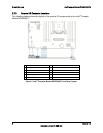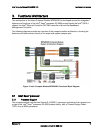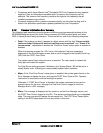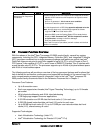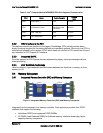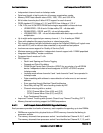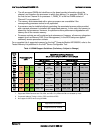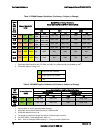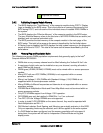
Intel
®
Compute Module MFS2600KI TPS Functional Architecture
Revision 1.0 9
Intel order number: G51989-002
Error
Severity
System Action
Processor Intel
®
QuickPath
Interconnect link frequencies
not identical
Fatal
The BIOS detects the QPI link frequencies and responds as follows:
Adjusts all QPI interconnect link frequencies to highest common
frequency.
No error is generated – this is not an error condition.
Continues to boot the system successfully.
If the link frequencies for all QPI links cannot be adjusted to be the
same, then this is an error, and the BIOS responds as follows:
Logs the POST Error Code into the SEL.
Alerts the BMC to set the System Status LED to steady Amber.
Displays “0195: Processor Intel
®
QPI link frequencies unable
to synchronize” message in the Error Manager.
Does not disable the processor.
Takes Fatal Error action (see above) and will not boot until the fault
condition is remedied.
3.2 Processor Functions Overview
With the release of the Intel
®
Xeon
®
processor E5-2600 product family, several key system
components, including the CPU, Integrated Memory Controller (IMC), and Integrated IO Module
(IIO), have been combined into a single processor package and feature per socket; two Intel
®
QuickPath Interconnect point-to-point links capable of up to 8.0 GT/s, up to 40 lanes of Gen 3
PCI Express* links capable of 8.0 GT/s, and 4 lanes of DMI2/PCI Express* Gen 2 interface with
a peak transfer rate of 5.0 GT/s. The processor supports up to 46 bits of physical address space
and 48-bit of virtual address space.
The following sections will provide an overview of the key processor features and functions that
help to define the architecture, performance and supported functionality of the server board. For
more comprehensive processor specific information, refer to the Intel
®
Xeon
®
processor E5-
2600 product family documents listed in the Reference Document list in Chapter 1.
Processor Core Features:
Up to 8 execution cores
Each core supports two threads (Intel
®
Hyper-Threading Technology), up to 16 threads
per socket
46-bit physical addressing and 48-bit virtual addressing
1 GB large page support for server applications
A 32-KB instruction and 32-KB data first-level cache (L1) for each core
A 256-KB shared instruction/data mid-level (L2) cache for each core
Up to 20 MB last level cache (LLC): up to 2.5 MB per core instruction/data last level
cache (LLC), shared among all cores
Supported Technologies:
Intel
®
Virtualization Technology (Intel
®
VT)
Intel
®
Virtualization Technology for Directed I/O (Intel
®
VT-d)






